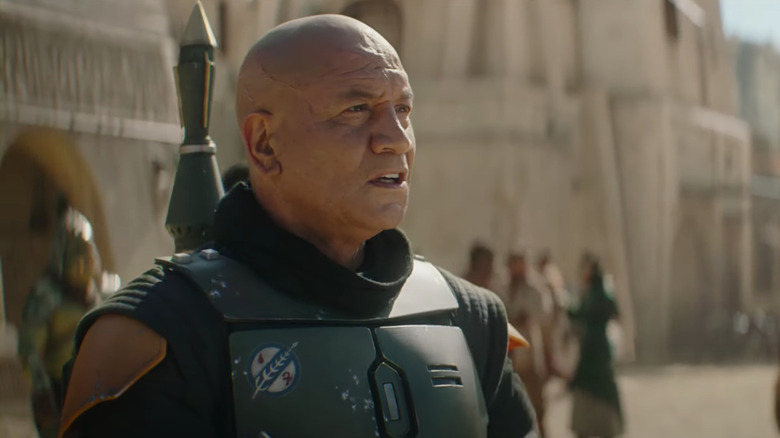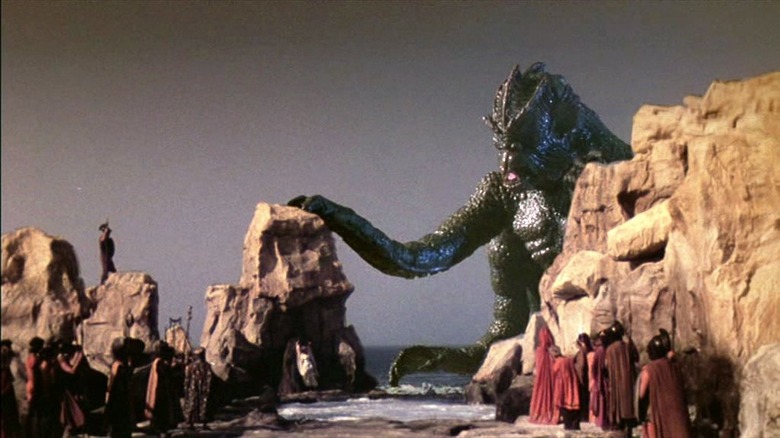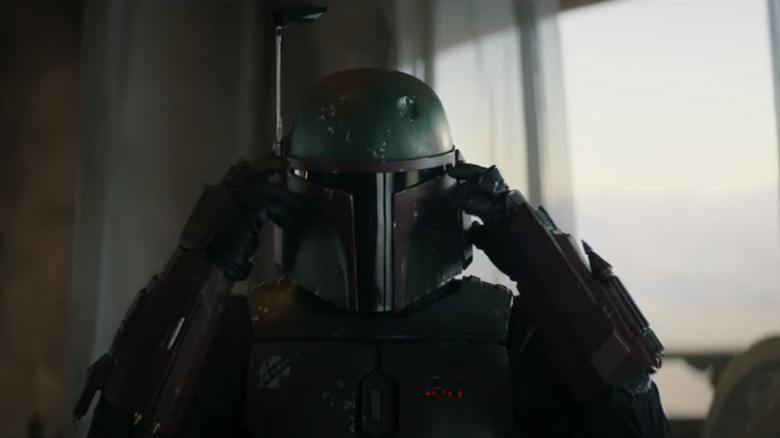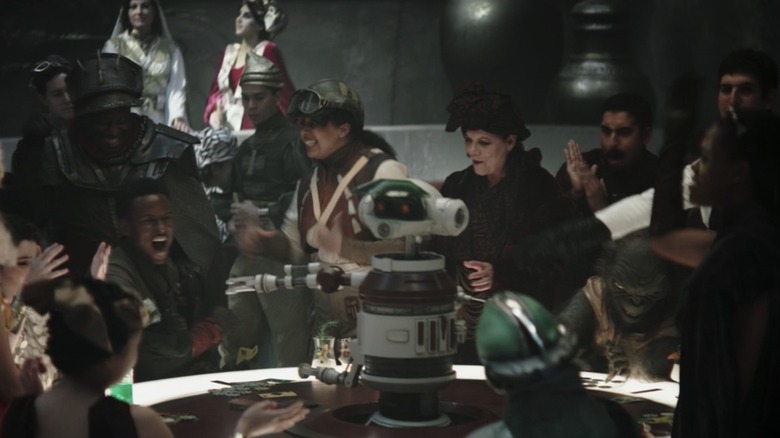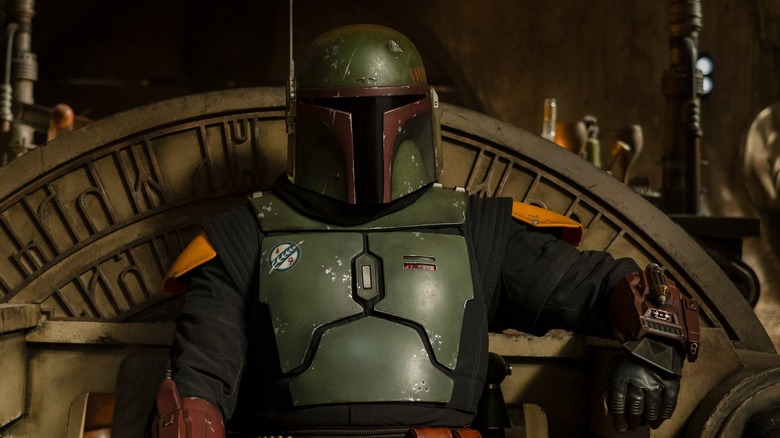The Book Of Boba Fett Review: Boba Fett Treads Familiar Ground In 'Stranger In A Strange Land'
Warning: there are spoilers for the first episode of "The Book of Boba Fett" ahead.
Directed by Robert Rodriguez and written by Jon Favreau, the first episode of "The Book of Boba Fett" shows us two timelines. First is the present, established at the end of the last episode of the second season of "The Mandalorian," where Boba Fett (Temuera Morrison) is wrestling for control of Jabba the Hutt's criminal Empire on Mos Espa with the help of Fennec Shand (Ming-Na Wen). The second timeline answers questions about Fett's escape from the Sarlacc pit, where he was left for dead in the events of "Return of the Jedi."
Boba Fett is changed, but we're not exactly sure how or why. He's less ruthless and more "honorable" than we've seen him in past iterations and the flashbacks of his previous timeline hope to give us some of the context that will allow us to understand how he changed. With somewhere between three and five years between the flashbacks and the present timeline, there is a lot of ground for the show to cover to show us these changes. (NOTE: Some outlets will definitely offer a set time, but there has been nothing in the canon to place "The Mandalorian" or "The Book of Boba Fett" into any specific period of time beyond a few years after "Return of the Jedi." Until there is a story reason for it to be set in stone, don't expect a definitive place to put this on your timeline.)
The Direction and Film References
Indie action mainstay and auteur Robert Rodriguez leaves his personal mark on the world of "Star Wars" once again. His first outing in a galaxy far, far away came late in the second season of "The Mandalorian." He directed the episode "The Tragedy," which saw Grogu ripped from the Jedi pedestal on Tython and reintroduced Boba Fett into the world of "Star Wars."
The episode pays homage to every era of "Star Wars," giving us flashbacks to the prequels (even using what appear to be alternate takes from "Attack of the Clones") and the classic trilogy as well. From the Tusken Raiders to the look of Jabba's Palace, everything feels ripped right out of the previous installments of "Star Wars" and reformulated for this new era.
For Rodriguez, the episode plays to his strengths, interests, and filmography. The action plays like it could have come out of one of his "Mariachi" films and the blistering heat of the Tatooine suns comes across in the warm tones across the episode.
Rodriguez's love of Ray Harryhausen is on full display in this episode. Harryhausen was a master of stop-motion animation, working on such important films as "The 7th Voyage of Sinbad" (which we wrote about here) and "Clash of the Titans," Rodriguez has done nothing to hide his love for his work. In "Spy Kids 2: Island of Lost Dreams," Rodriguez put this love on the big screen for the first time. Although digital animation was used, he embraced the stop-motion aspects of Harryhausen's spectacle. He's done it again here with Boba Fett's fight with the Tatooine sand creature, giving that hand-made puppet quality to the monster that very much resembles a "Star Wars" version Harryhausen's Kraken from 1981's "Clash of the Titans".
Setting the Stage
This episode works hard to show us things we know, or think we know. It was apparent that Boba Fett got out of the Sarlacc, but now we get to see it. Thanks to the work of Chuck Wendig in the "Aftermath" books and even implications from Cobb Vanth in "The Mandalorian," we know that Jawas ended up with Boba's armor, now we get to see it. With Boba Fett's introduction on "The Mandalorian," we were able to assume he had some dealings with Tusken Raiders by his use of a gaderffii, their traditional weapon, but now we get to see how that plays out.
To be honest, not a lot of new ground was broken here. We're being shown a lot of things that were easy to make suppositions about if you had been paying attention to the canon. Rodriguez manages to make it entertaining, though.
This episode sets up the potential for many showdowns in a classic underworld story. The excitement of underworld movies and stories comes from the internal drama of the families involved and the struggle to maintain a criminal empire when there was literally no one around you could trust. "The Book of Boba Fett" makes promises to deliver on that thrill.
What to Watch Out For
There are quite a few nods worth noting in this episode. The most fun might be the inclusion of the droid 8D8. 8D8 was seen in Jabba's droid torture room in "Return of the Jedi", torturing a GONK droid and generally assisting the incredibly evil droid EV-9D9, who gave Artoo and Threepio their assignments when they were given to Jabba. It's no wonder that 8D8 is so keen on torture in the name of Boba Fett as that is his primary function. No word on what happened to EV-9D9, but 8D8 is a welcome touch.
Once inside the cantina of Garsa Fwip (Jennifer Beals), we're treated to a number of fun sights and sounds for fans of "Star Wars." First, the band looks like a blend between the Max Rebo band and Figrin D'an and the Modal Nodes, both bands that were featured on Tatooine in the classic trilogy. Whether it's them or not is anyone's guess, but they do play a smooth rendition of the original Cantina Band theme song. Their astromech drummer really completes the trio.
Fans of Star Tours and Galaxy's Edge at Disney theme parks will no doubt recognize the dealer at the gambling table in Garsa Fwip's sanctuary as an RX-series pilot droid. Although this one doesn't speak, RX-series droids have typically been voiced in "Star Wars" by Paul Ruebens.
Other eagle-eyed fans might notice that the Trandoshan, Dokk Strassi, who brings Boba Fett tribute does so with a Wookiee-hide. Trandoshans have long hunted Wookiees for sport — something we saw first hand in "The Clone Wars" — but Boba Fett's costume also sported braids of Wookiee-hide in the classic trilogy. Perhaps with the gift from Dokk Strassi, he will put them back on his costume. Another fun fact about Dokk Strassi, though, is that he is played by none other than Robert Rodriguez, giving the director a wonderful cameo.
As far as the other major cameo in the episode, it comes from comedian David Pasquesi, playing the Mayor of Mos Espa's Majordomo. "Star Wars" has had a great run of casting comedians in key roles on their television shows and Pasquesi's weaselly Majordomo is no exception. He was also in "Strangers with Candy," which starred another comedian-turned-"Star Wars" actor: Amy Sedaris AKA Peli Motto on "The Mandalorian."
The Verdict
This first episode of "The Book of Boba Fett" was fun to watch, especially showing them embrace the prequels past of the character with cameos by Daniel Logan straight from "Attack of the Clones," but the entire thing felt a little obvious.
Boba Fett has changed from what we knew him as before on "The Clone Wars" and in the classic trilogy. Seeing what has changed him will be an interesting journey and really is, so far, the central question of the show.
For now, it's enough to keep me watching, but I hope we get into a more complicated story that takes us new places soon and I hope they grapple with more of what it means to be a clone in a galaxy that used them as their soldiers for so long.
"Book of Boba Fett: Chapter 1 – Stranger in a Strange Land" is now playing on Disney+. New episodes of "The Book of Boba Fett" premiere on Wednesdays.
